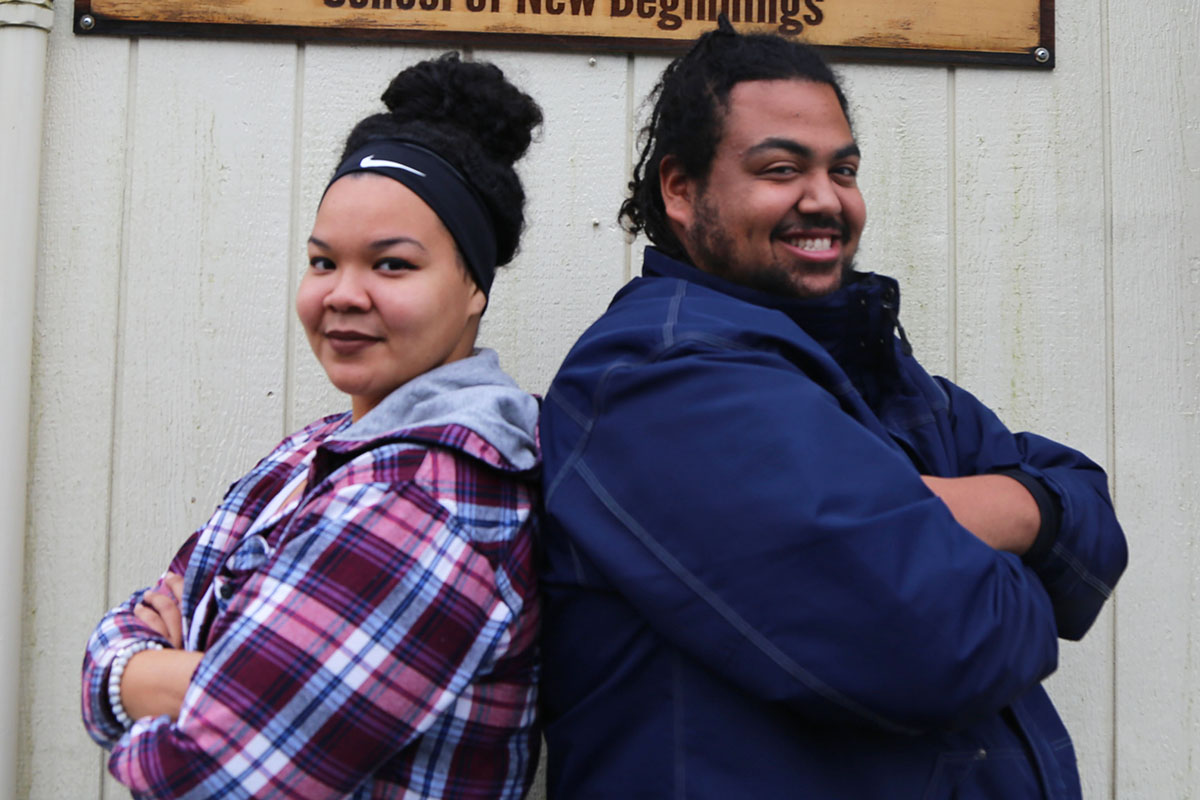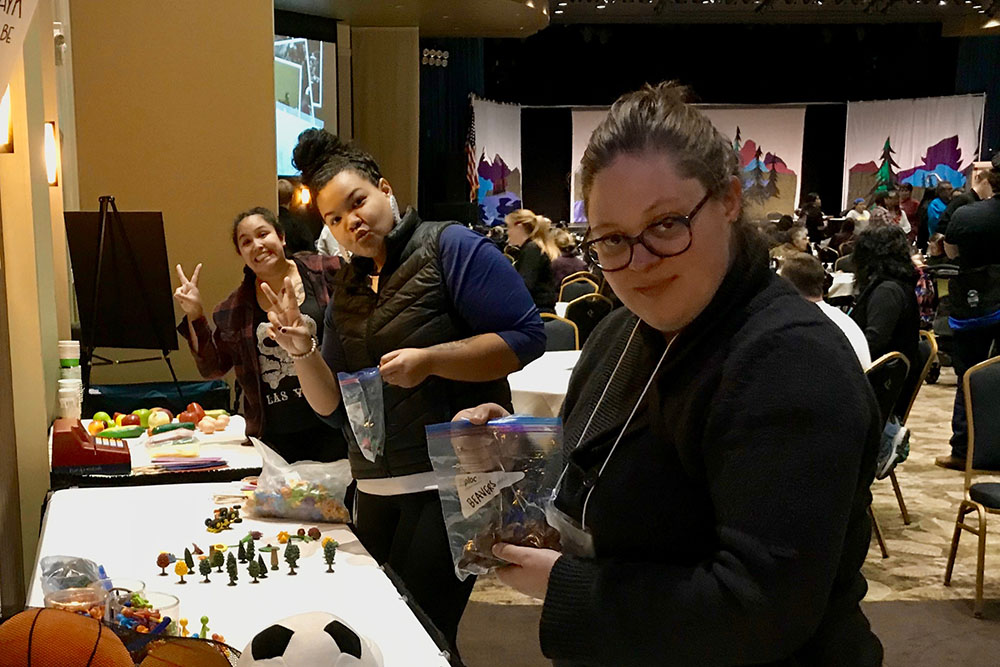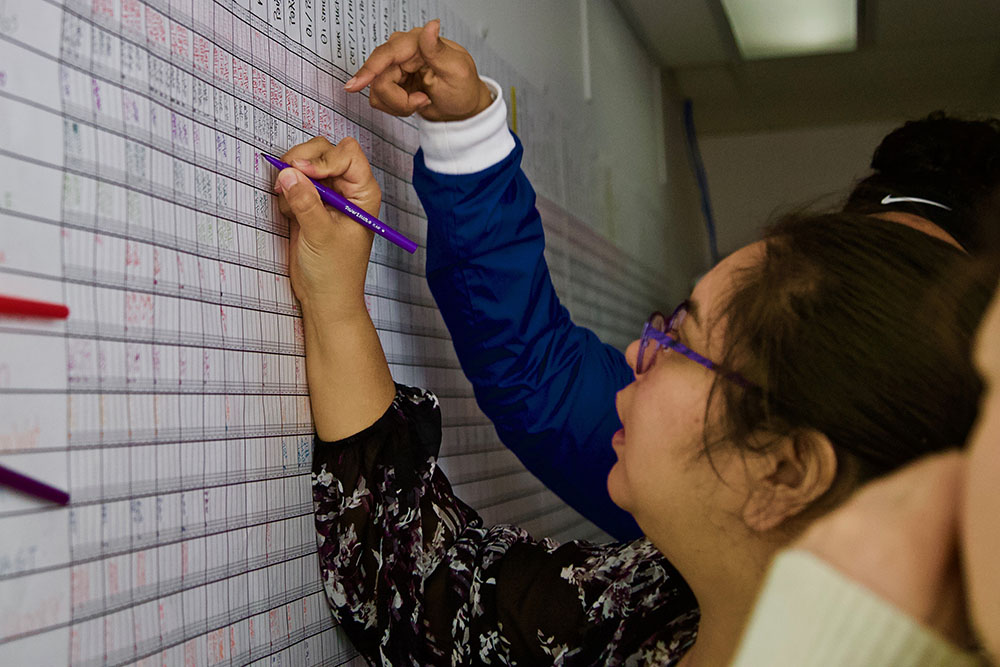
By Jamuna Galay-Tamang and Brenden Dixon
Tsleil-Waututh language teachers Kalila George-Wilson and Nick George lead their class in a hən̓q̓əmin̓əm translation of the song Head and Shoulders, Knees and Toes.
“Sx̌aýes, xwǝq́wten, sqǝlṕalθǝtǝn, snǝx̌xǝn. Sx̌aýes, xwǝq́wten…”
Students stand scattered around a table, bobbing up and down, pointing at body parts as they sing along. George and George-Wilson have an infectious exuberance and laughter fills the room.
Their passion for teaching extends beyond these bi-weekly classes in the Tsleil-Waututh Nation (TWN) administration building of North Vancouver. In recent months, the teachers have connected with Indigenous language educators from the neighbouring Sḵwx̱wú7mesh Nation, other Salish nations in the United States and even the Maori of New Zealand.
For a tiny nation that has no mother tongue speakers left, these relationships are essential to their language’s survival.

‘It gave me more passion to fight harder’
George-Wilson and a few TWN language team members returned from the Celebrating Salish Conference, recently held in Spokane, Wash., with a stronger sense of connection with their international relations.
“I didn’t know how similar our languages were,” she said.
“It makes sense, our people moved around a lot.”
Tsleil-Waututh peoples traditionally spoke hən̓q̓əmin̓əm, known also as “downriver” Halkomelem. It’s one of many dialects under the Coast Salish umbrella, encompassing 14 languages across British Columbia, Washington and Oregon.
The Kalispel Tribe hosted teachers, learners and activists of Interior and Coast Salish languages in the event that featured TWN’s Where Are Your Keys? presentation. The WAYK program was created by linguist Evan Gardner and uses American Sign Language and contextual learning, rather than translating from English, to teach spoken languages.
Teachers also learned about youth leadership and new ways to teach math and science in immersion classrooms. For fun, they could sing along to Salish karaoke.
“Now we have connections through all of Salish Territory,” George-Wilson said.
“It gave me more passion to fight harder.”
A natural swap
She may not have grown up speaking her language, but George-Wilson is now learning four Salish dialects. Historically, multilingualism was a practical necessity among Salish nations because of intermarriage and politics.
TWN’s collaboration with the Simon Fraser University Sḵwx̱wú7mesh language team follows this tradition. The languages are similar enough that understanding one helps to improve the other.
“By learning Sḵwx̱wú7mesh, it boosted my Hul’q’umi’num’ speaking. I figured out things that I didn’t even know I knew in Hul’q’umi’num’ while I was learning Sḵwx̱wú7mesh,” George-Wilson said.
The TWN team shares their WAYK methods such as the “hunting” technique, where language learners use objects in their environment to find words in other languages without translation. The SFU group, meanwhile, has more fluency in Sḵwx̱wú7mesh, which helps to fill in the gaps for TWN’s language speakers.
The interaction helped both teams create new lessons quickly.
“There was a real natural swap,” said Evan Gardner.
His ‘Where Are Your Keys?’ language learning method has been adopted by both nations.
“Just one day of that can really increase the speed of transfer of language in their own classroom.”
Gardner and his partner Susanna Ciotti have travelled to Indigenous communities across North America, collaborating with local teachers to expand their language programs.
“One of the patterns of successful communities is people are not trying to do it alone,” Ciotti said.
Collaboration is an opportunity to share ideas and techniques, or to combine them. George-Wilson’s cousin George, who she refers to as her brother, has joined her in learning Sḵwx̱wú7mesh. It helped improve his language skills and strengthen his family connections.
“My grandfather, he spoke Sḵwx̱wú7mesh,” George said.
“I didn’t really know him too well growing up, so it’s like my way of being able to learn about him and how he lived his life.”

‘What the future can look like’
While George-Wilson is a natural leader in the classroom, George finds he’s in his element when teaching at the daycare.
“People get so excited when I talk to their kids in the language . . . they’re like ‘Oh that’s so awesome.’ That’s a good feeling.”
George looks forward to his sister’s latest initiative to design immersion curriculum for TWN’s daycare, inspired by her visit to the Maori, the Indigenous people of New Zealand (Aotearoa in Maori), earlier this year.
In the 1980s, Maori leaders established “language nest” primary schools to preserve the language. They’ve since expanded into an entire immersion schooling system. These initiatives have helped keep fluency above 20 per cent and, today, more than half of Maori can speak some te reo.
George-Wilson toured some of their immersion classes and plans to approach her daycare lessons in the same fun and practical style.
“I was like ‘Wow, what is this? Real people do this?'” George-Wilson says about te reo’s integration.
Waking up
George-Wilson and George are optimistic for the small nation’s big language goals after witnessing the successes of other nations.
“After you go there and you see how they are, you can see what the future can look like for your people here,” George-Wilson said.
Language initiatives are generally supported in the community, but it can be a challenge to get people into classrooms. Even so, she believes that’s changing.
“I know it’s going to happen one day. I know it’s going to be where everybody will be able to speak here,” she said.
“It’s not a dream, it’s a plan.”
About the authors
Jamuna Galay-Tamang carries Nepali, Dene-Metis & Ukrainian ancestry and aims to amplify the voices of peoples and places with stories yet unheard. Twitter: @jamunagt
Brenden Dixon is a London, ON born-and-raised theatre kid and high-functioning introvert who likes dogs more than people. He has a background in biology, but nowadays, spends him time following the intersection of politics, science, climate change and social justice.

